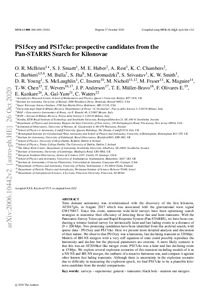PS15cey and PS17cke: prospective candidates from the Pan-STARRS Search for kilonovae
McBrien OR; Smartt SJ; Huber ME; Rest A; Chambers KC; Barbieri C; Bulla M; Jha S; Gromadzki M; Srivastav S; Smith KW; Young DR; McLaughlin S; Inserra C; Nicholl M; Fraser M; Maguire K; Chen TW; Wevers T; Anderson JP; Muller-Bravo TE; Olivares EF; Kankare E; Gal-Yam A; Waters C
PS15cey and PS17cke: prospective candidates from the Pan-STARRS Search for kilonovae
McBrien OR
Smartt SJ
Huber ME
Rest A
Chambers KC
Barbieri C
Bulla M
Jha S
Gromadzki M
Srivastav S
Smith KW
Young DR
McLaughlin S
Inserra C
Nicholl M
Fraser M
Maguire K
Chen TW
Wevers T
Anderson JP
Muller-Bravo TE
Olivares EF
Kankare E
Gal-Yam A
Waters C
OXFORD UNIV PRESS
Julkaisun pysyvä osoite on:
https://urn.fi/URN:NBN:fi-fe2021042821351
https://urn.fi/URN:NBN:fi-fe2021042821351
Tiivistelmä
Time domain astronomy was revolutionized with the discovery of the first kilonova, AT2017gfo, in August 2017, which was associated with the gravitational wave signal GW170817. Since this event, numerous wide-field surveys have been optimizing search strategies to maximize their efficiency of detecting these fast and faint transients. With the Panoramic Survey Telescope and Rapid Response System (Pan-STARRS), we have been conducting a volume-limited survey for intrinsically faint and fast-fading events to a distance of D similar or equal to 200 Mpc. Two promising candidates have been identified from this archival search, with sparse data - PS15cey and PS17cke. Here, we present more detailed analysis and discussion of their nature. We observe that PS15cey was a luminous, fast-declining transient at 320 Mpc. Models of BH-NS mergers with a very stiff equation of state could possibly reproduce the luminosity and decline but the physical parameters are extreme. A more likely scenario is that this was an AT2018kzr-like merger event. PS17cke was a faint and fast-declining event at 15 Mpc. We explore several explosion scenarios of this transient including models of it as a NS-NS and BH-NS merger, the outburst of a massive luminous star, and compare it against other known fast-fading transients. Although there is uncertainty in the explosion scenario due to difficulty in measuring the explosion epoch, we find PS17cke to be a plausible kilonova candidate from the model comparisons.
Kokoelmat
- Rinnakkaistallenteet [27094]
